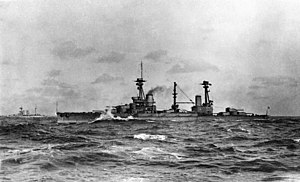 Agincourt in 1915
| |
| History | |
|---|---|
| Name | Rio de Janeiro |
| Namesake | Rio de Janeiro |
| Builder | Armstrong, Newcastle upon Tyne |
| Cost | $14,500,000 (estimated)[1] |
| Yard number | 792 |
| Laid down | 14 September 1911 |
| Launched | 22 January 1913 |
| Fate | Sold December 1913 to the Ottoman Empire |
| Name | Sultan Osman-ı Evvel |
| Namesake | Sultan Osman I |
| Acquired | December 1913 |
| Fate | Seized in August 1914 by the United Kingdom |
| Name | Agincourt |
| Namesake | The Battle of Agincourt of 1415 |
| Cost | £2,900,000 (estimated)[2] |
| Completed | 20 August 1914 |
| Acquired | 3 August 1914 |
| Commissioned | 7 August 1914 |
| Decommissioned | April 1921 |
| Nickname(s) | Gin Palace |
| Fate | Sold for scrap, 19 December 1922 |
| General characteristics (in British service) | |
| Type | Dreadnought battleship |
| Displacement | |
| Length | 671 ft 6 in (204.7 m) |
| Beam | 89 ft (27.1 m) |
| Draught | 29 ft 10 in (9.1 m) |
| Installed power |
|
| Propulsion | 4 × shafts; 4 × steam turbines |
| Speed | 22 knots (41 km/h; 25 mph) |
| Range | 7,000 nmi (13,000 km; 8,100 mi) at 10 knots (19 km/h; 12 mph) |
| Complement | 1268 (1917) |
| Armament |
|
| Armour | |
HMS Agincourt was a dreadnought battleship built in the United Kingdom in the early 1910s. Originally part of Brazil's role in a South American naval arms race, she holds the distinction of mounting more heavy guns (fourteen) and more turrets (seven) than any other dreadnought battleship, in keeping with the Brazilians' requirement for an especially impressive design.
Brazil ordered the ship in 1911 as Rio de Janeiro from the British company Armstrong Whitworth. However, the collapse of Brazil's rubber boom and a warming in relations with Argentina, the country's chief rival, led to the ship's sale while under construction to the Ottoman Empire. The Ottomans renamed her Sultan Osman I, after the empire's founder, and the ship was nearly complete when the First World War broke out. The British government seized her for use by the Royal Navy, together with another Ottoman dreadnought being constructed in Britain. This act caused resentment in the Ottoman Empire, as the payments for both ships were complete, and contributed to the decision of the Ottoman government to join the Central Powers.
Renamed Agincourt by the Royal Navy, she joined the Grand Fleet in the North Sea. During the war, the ship spent the bulk of her time on patrols and exercises, although she did participate in the Battle of Jutland in 1916. Agincourt was put into reserve in 1919 and sold for scrap in 1922 to meet the terms of the Washington Naval Treaty.
- ^ "Brazil's 32,000-Ton Dreadnought," Bulletin of the International Bureau of the American Republics 31, no. 1 (July 1910): 515.
- ^ Cite error: The named reference
b45was invoked but never defined (see the help page).